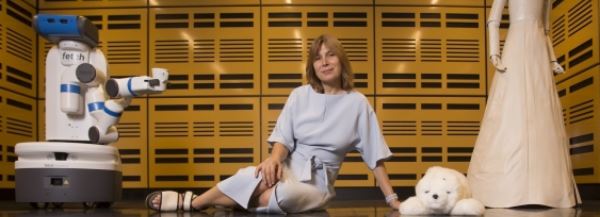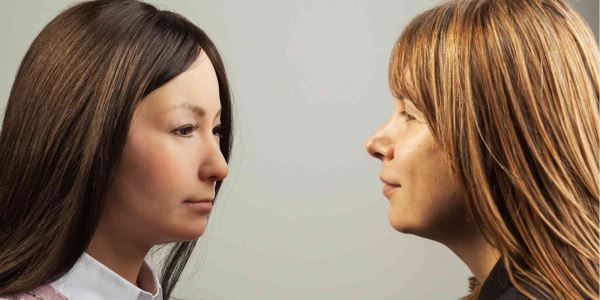When discussion turns to robots, it is often to lament the prospect of automated industrial machines replacing humans in the workplace.
Professor Mari Velonaki envisions a less gloomy future: “We are not interested in building machines that will replace humans; we are interested in creating systems that enhance humans,” she says.
As the Director of UNSW’s Creative Robotics Lab, Professor Velonaki has spent the past five years leading a pioneering multidisciplinary team from UNSW Art & Design, the School of Computer Science & Engineering and the School of Psychology to discover how humans can interact with robots to benefit society.
Over the next year, the lab will play a leading role in the establishment of the new National Facility for Human-Robot Interaction Research and introduce a new multidisciplinary undergraduate program in social robotics.
“We take a very strong position in our lab about social robotics and why we need to develop new technologies,” Professor Velonaki says. “Ideologically, we believe that if you are going to put all the resources, human and material, into designing a new technological system, it has to have a positive function in society.”
Collaboration with Fuji Xerox
That ideology is obvious in a recent collaboration with the Fuji Xerox Technology Group, in which the Creative Robotics Lab developed a social robot to enhance workplace experiences for employees by streamlining administrative tasks, giving them more time to create and collaborate. The robot, which is being tested in Fuji Xerox’s offices in Japan, will gather data from the interactions to inform future research and development in social robotics.
Two other robots, Paro and Kaspar, act as psychological enrichment tools for use in research in the Creative Robotics Lab.
Paro is a fluffy white seal built to help people with dementia to communicate. The patients respond to Paro because it feels good to touch and encourages conversation.
“Interestingly, Paro became a conversation starter for people who were very reclusive and didn’t want to interact with anything,” Professor Velonaki says.
Helping autistic children
Kaspar is a doll-like social robot that teaches children with Autism Spectrum Disorder to feel more comfortable with social interaction. He might look plain but his mask-like features were based on feedback from children with the disorder.
“Even with mid-range autism, children don’t feel comfortable with face-to-face gazing. They were comfortable with Kaspar so they were going to learn from that,” Professor Velonaki says.
The National Facility for Human Robot Interaction Research, which will open in mid-2018, is a partnership between UNSW (Art & Design, Computer Science and Engineering, School of Psychology), UTS (Centre for Autonomous Systems), the University of Sydney (Australian Centre for Field Robotics, School of Information Technologies) and St Vincent’s Hospital (Department of Rehabilitation Medicine).
Game changer
It includes a test space equipped with a fully functional kitchen and more than 200 sensors, unidirectional microphones, infrared cameras and lasers that can record real-time information about human interactions as rehab patients move around within it.
“The facility will be a game changer because we will be able to unobtrusively collect extremely important data about how a person going through rehabilitation operates in space without them having to wear any sensors,” Professor Velonaki says. “I think it will also influence the way we design robots and the way we evaluate robots before they go out into society because we can learn so much more about human interactions.”
A new three-unit multidisciplinary undergraduate program will begin in 2019 and Professor Velonaki says this will place UNSW as a world leader in teaching social robotics.
“I have always wanted to curate a course that talks about all the different things that can influence human robotics and create a map for future researchers,” she says. “It is a growing area in academia and I think it is critical for us to be pioneers in it. We would like to offer something hands-on to demystify social robotics.
Art and science should work together
With an academic background in media arts followed by 10 years of Australian Research Council-funded research in a robotics centre, Professor Velonaki believes that art and science should inform one another for the benefit of humanity.
“It is nothing new: the Da Vinci model states that art and science should work together,” she says. “Art should be there from the beginning because there are a lot of creative principles involved when you design a system that is going to be in society. You want to have art and design principles and you want them to be interesting.
“I want social robotics at UNSW and in Australia to lead with ethical design, creativity and with all the disciplines working together at a level where we can actually produce new research that will hopefully inform us to build better systems as a community.”
Future roles for social robots
Professor Velonaki sees future roles for social robots in healthcare and education, where she believes they will enhance the jobs of busy professionals and allow them to concentrate on providing human interactions.
“I think we are in a position to shape the future, but we need to take responsibility for shaping the future of society, not just academia. I think it is very important to design technological systems that enhance humanity, not take away from it,” she says.
Ultimately, Professor Velonaki believes that the biggest challenge to building social robots is humans: “Because they are unpredictable and imaginative and difficult and inspiring and there’s all these wonderful things that humans are. In social robotics I think the challenge is to create systems that can enhance all of these human qualities.”
Source: University of NSW


